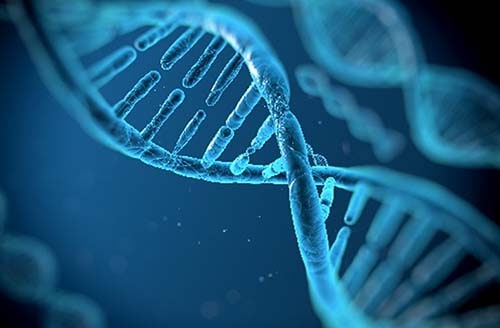From the moment a baby is conceived, genes control his/her development and health. But they don't do it alone. The exposome—which is all the internal and external chemical exposures experienced during our lives—influences, for better or worse, the genes and proteins they code for. A better understanding of the exposome would help scientists identify how nongenetic factors influence biological reactions and possibly contribute to the development of chronic diseases.

What is the exposome?
The human exposome is the environmental equivalent of the human genome. It represents the complex exposures humans are subjected to throughout their lifetimes, including diet, lifestyle factors, and social influences: the food we eat and the drugs we take, pollutants in our water and air, ionizing radiation from sunlight and other sources, the biosynthetic activity of the bacteria living in and on us, and even noise pollution. The exposome also incorporates how our bodies respond to these challenges; it encompasses much of what we refer to as "nurture." Yet little is known about how these exposures really affect humans or potentially influence the onset of diseases such as cardiovascular disease, diabetes, asthma, Alzheimer's, cancer, and other chronic conditions.
Origins of the exposome science
There is an equation in genetics: P = G + E. In English, it means that an individual's Phenotype (observable health and physical traits) is the sum of his/her Genetics and Environment. Perhaps the E should stand for "Exposome," a term first used by cancer epidemiologist Christopher Wild in his 2005 article, “Complementing the Genome with an ‘Exposome': The Outstanding Challenge of Environmental Exposure Measurement in Molecular Epidemiology." In the article, Dr. Wild discussed the importance and potential impact of environmental exposures on human health. He posited that the best way to characterize these impacts would be to apply tools used in genomics, proteomics, and metabolomics.

Exposome encompasses a lifetime of exposures
Unraveling the exposome requires identification, characterization, and quantification of the exogenous and endogenous exposures that humans encounter, as well as modifiable risk factors that predispose a person to diseases throughout his or her lifespan. As mentioned, the exposome concept came as a complement to the human genome idea. Although decoding the human genome increased our understanding of the underlying genetic causes of disease, genomic analysis only explains part of the disease burden.
Simultaneously consider both nature and nurture
Environmental and lifestyle factors are equally or even more important than genetics in determining susceptibility, onset, and exacerbation of human disease. Exposome science promises to provide the conceptual framework to understand the complex web of interactions between genes and the environment and their causal association to disease. It provides the impetus to overhaul the nature versus nurture dilemma towards an integrated perspective of human disease defined by complex and dynamic interactions between DNA sequence, epigenetic DNA modifications, gene expression, metabolite profiling, and environmental factors that all combine to influence disease phenotypes.
Enter the exposome paradigm
The exposome paradigm studies nongenetic causes of chronic disease. To use this paradigm to decipher the complex interactions that cause or exacerbate human disease, one must assess the connectivity among various risk factors and modifiers at various biological dimensions. This interplay defines human susceptibility to external stressors.
The exposome paradigm motivates studies of nongenetic causes of chronic diseases in much the same manner that a genome-wide association study (GWAS) explores genetic causes. Description of the human exposome requires a wide array of state-of-the-art technologies that span environmental and exposure science and engineering, biochemistry, molecular biology, toxicology, bio-informatics, and epidemiology. These techniques are organized in specific workflows that provide additional insights into the environmental burden of disease.

The human genome and disease research
One of the greatest scientific achievements in the past 30 years has been sequencing the human genome. Since then, the primary focus of disease research has been identifying statistical associations between the most common type of genetic variation and disease in large studies commonly referred to as genome-wide association studies.
Although these studies have shed great light on many factors that cause disease, it is increasingly evident that genetic factors alone may not be the main cause of disease. Overall, genetics accounts for less than 20 percent of disease, ranging from about 3 percent for leukemia to nearly 50 percent for asthma. The genetic heritability of disease at the population level averages around 50 percent.
In fact, many chronic diseases do not have a purely genetic origin, something scientists have known for decades, and nongenetic factors have been shown to play an increasingly dominant role in their contribution to disease.

A new era in environmental health science
Exploring disease causality instead of just associations with health stressors and risk-modifying factors requires a mechanistic understanding of all intermediate events related to perturbed homeostasis. Identification of perturbations requires high-throughput data acquisition and interpretation supported by systems biology models and advanced bio-informatics. With these tools, the actual biological and metabolic pathways related to adverse health outcomes can be distinguished from perturbations that are efficiently overcome by inherent defense mechanisms.
Considering health-risk assessment, the exposome paradigm opens the way to a new era in environmental health science and chemical risk assessment; it brings together high-throughput analytical tools, big data analytics, and biology-inspired modeling to understand the multicausal associations of complex diseases. The good news is that this is now happening with governments around the world recognizing this disparity and funding large-scale exposome research.
Conclusion
The exposome paradigm will facilitate the translation of applied research into educational, behavioral, and policy-based, risk-mitigating interventions. It is a complex research area that requires broad-based, sophisticated tools. Agilent provides a wide range of hardware, software, and informatics solutions for this multi-omics research, including chemical and biological analysis systems ranging from research-grade liquid phase and gas phase quadrupole time-of-flight mass spectrometers, triple quadrupole mass spectrometers, inductively coupled plasma mass triple quadrupole mass spectrometers, real-time PCR, and sophisticated software such as Agilent Mass Hunter Profiler Professional, to tease out disease associations from complex, multi-dimensional datasets.
Visit Agilent.com to discover and learn more about the complete set of integrated biology solutions that scientists can apply to unravel the exposome.
Find out more:
- Agilent ICP-MS
- Agilent GC/Q-TOF
- Agilent LC/Q-TOF
- Agilent Real-Time PCR
- Agilent MassHunter Profiler Professional